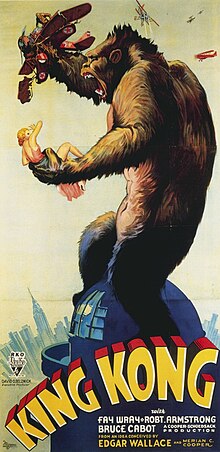
The Como Theatre, reborn from the failed Cygnet Cinema, has recently begun holding screenings of retro movies - particularly pre-digital releases on film - to a niche audience. This began with a revival of Exhumed Cinema and has continued with others, including the only copy of King Kong on 35mm film in Australia.
Going into the film I was expecting a number of tropes common to older cinema: slow pacing, extensive expository dialogue, fixed cameras, theatre-style script, and few action sequences. What I experienced was very unlike this at all. The pacing is much closer to a modern Marvel film with extended action sequences - the second half of the film has ten-minute action sequences interspersed with short dialogue.
Very little of the dialogue is expository - beyond the opening sequences the film takes a very modern approach of showing the action without an narrative - diagetic or extra-diagetic. The ground-breaking special effects that combine live-action with miniatures, back projection, and matte paintings, also allowed for surprisingly dynamic camera angles including the memorable scene where the camera pans across the stegasaurus corpse as the men walk past it.
For a film that is remembered almost entirely for its special effects, the dialogue has surprising depth. Robert Armstrong as Carl Denham speaks at length about the studio forcing him to include a romantic sub-plot in his film in what is an ironic reflection of the film itself. His commentary about the box-office appeal of a giant ape is further ironic reflection of the exploitative nature of this film, given that it was green-lit primarily on the commercial success of racist movie-goers horror at white women in peril to very thinly coded black men.
And the film contains the extraordinarily open racism of the time. Kong himself is a barely veiled metaphor for sexually aggressive black men and the horror that white society held towards them. The victory of guns, bombs, and planes over not just Kong but also the villagers, is straightforward white supremacy - as is the "kill any creature that moves" attitude of the crew.
The sexism of the film, though, doesn't stand out at all, matching contemporary standards rather well. Fay Wray as Ann Darrow is the only female character in the film, but this is exactly the same in Peter Jackson's 2005 remake. And lest you think this is because of a desire to cleave close to the source, the 2017 reboot is perhaps even worse.
Perhaps the most modern aspects of this film are the action sequences. Although the technology has aged poorly, the overly long fight sequences and destruction scenes included purely for spectacle feel far more like a modern action movie than vintage cinema. Kong's destruction of the train in New York has no narrative purpose at all and must have cost an extraordinary amount to film and yet is included for two purposes: to show that they can, and for the spectacle.
Similarly modern is the over-stuffed feeling of Skull Island. It is not enough that we have Kong, but the film includes sequences with five other giant beasts (including one that is perhaps the inspiration for the Loch Ness monster). Clearly inspired by Journey to the Center of the Earth and The Lost World, the film insists on presenting beast after beast in what feels more like a modern sequel than a vintage original.
Some welcome familiarity comes in the imagery reminiscent of Jurassic Park - most notably in the park's entrance echoing Kong's gate and the goat and T-rex scene similarity to Ann's offering to Kong. In fact, the island full of dinosaurs, the failure of containment, and the ultimately destructive hubris of bringing the beast to the US forms the basis for much of the Jurassic Park franchise. Even the sequence where the brachiosaurus eats a sailor has a lot in common with the T-rex eating the lawyer in Jurassic Park.
The enduring strengths of King Kong lie entirely in the effects technology that it pioneered. The combination of different special effects, such as miniatures with back projection, was innovative and spurred great development in these areas. It inspired entire genres going forward and became an instant classic. And despite some of it having aged poorly it was well worth an afternoon at the cinema.
Due to the age of the film, it is now in public domain and can be freely watched at the Internet Archive and elsewhere.